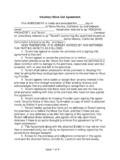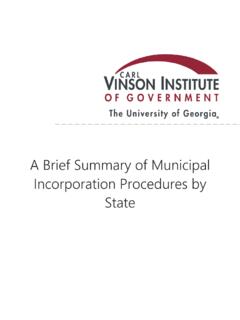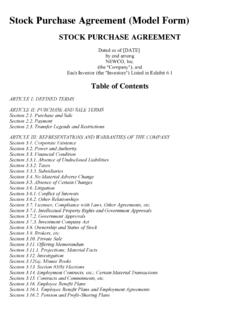Transcription of F. CORPORATE PRACTICE OF MEDICINE - IRS tax forms
1 F. CORPORATE PRACTICE OF MEDICINE by Charles F. Kaiser III and Marvin Friedlander 1. Introduction Some states--California, Texas, Ohio, Colorado, Iowa, Illinois, New York and New Jersey--preclude hospitals from employing physicians to provide out-patient services. These states legislate what is known as the CORPORATE PRACTICE of MEDICINE doctrine. The rationale for prohibiting employment of physicians by hospitals is derived from the concept that individual physicians should be licensed to PRACTICE MEDICINE not corporations. See Painless Parker v. Board of Dental Examiners, 216 Cal.
2 285, 14 67 (1932). The basic premise is the divided loyalty and impaired confidence between the interests of a corporation and the needs of a patient. In PRACTICE , states with CORPORATE PRACTICE of MEDICINE laws permit formation and licensure of business corporations established as professional service corporations (but not a non-profit corporation) to PRACTICE MEDICINE but only if controlled by physicians. See State Prohibition on Hospitals Employment of Physicians, "Department of Health and Human Services, Office of Inspector General," Document No.
3 OEI-01-91-00770 (November, 1991). The problem for a tax exempt hospital that wants to operate a wholly-owned, out patient clinic in a state with CORPORATE PRACTICE of MEDICINE laws is the clinic can't incorporate under the state's non-profit laws. Because professional service corporations are intended to operate as business enterprises, recognition of IRC 501(3) exemption requires a considerable number of safeguards to ensure charitable organization and operations. This article discusses exemption considerations where a hospital establishes an entity to provide out-patient physician services in states with CORPORATE PRACTICE of MEDICINE laws.
4 It also provides samples of exemption determinations issued in each such state. 2. What do CORPORATE PRACTICE of MEDICINE Laws Require? The CORPORATE PRACTICE of MEDICINE laws require corporations created to employ physicians in an outpatient clinic to be incorporated under the state's professional service CORPORATE laws. The laws also require all providers of medical services to be licensed. Often, the laws mandate that all stock in the corporation providing the services be held by a physician licensed in the state and all members of the board of directors be physicians licensed by the state.
5 Generally, one physician holds all the stock, but New York state law indicates all physicians employed by the professional service corporation may be shareholders. CORPORATE PRACTICE of MEDICINE 3. How is the Professional Service Corporation Established to Obtain Exemption? A professional service corporation issues all of its stock to a physician shareholder who normally becomes the CORPORATE director. A physician shareholder is a licensed physician who is generally employed on the administrative staff of an IRC 501(c)(3) hospital (or a tax-exempt entity within the affiliated hospital system) which acts like a parent of the professional corporation.
6 The physician shareholder may also be an employee of the professional service corporation. The physician shareholder, the professional service corporation (hereafter Professional Corporation) and the IRC 501(c)(3) hospital (hereafter the Parent) enter into a contractual arrangement--a shareholder control agreement --whereby all structural and financial control over the Professional Corporation is transferred to the Parent. Under the shareholder control agreement , the physician shareholder becomes a controlled physician shareholder by agreeing to hold the stock for the benefit of the Parent.
7 This type of legal arrangement is often referred to as a "captive professional corporation." In addition to the shareholder control agreement , control is exercised by the Parent over the director(s), the controlled, physician shareholder and the Professional Corporation through the following types of documents: by-laws, articles of incorporation , employment agreement (between the controlled, physician shareholder and the Parent), trust agreement (replaces a shareholder control agreement ), and a management agreement with an affiliated entity (in certain circumstances this is used by the Parent to assure further day-to-day control).
8 The Service requires the Parent to provide a written representation that it will exercise all of its rights in law and equity to prevent diversion or wasting of the Professional Corporation's charitable assets. This is done as an additional safeguard to any actions the state may take since the state's authority to enforce charity on a Professional Corporation is not entirely clear. IRC 501(c)(3) status for the Professional Corporation is based on derivative exemption through an integral part analysis. The Professional Corporation is treated as performing an essential function that furthers an exclusively exempt purpose of the Parent that controls it.
9 See Rev. Rul. 78-41, 1978-1 148. 4. Problems Created by CORPORATE PRACTICE of MEDICINE Laws A. Legal Verses Beneficial Ownership of Stock The Service is interested in receiving assurances, such as an opinion from the state attorney general, that legal ownership of the stock of a captive Professional Corporation, not beneficial ownership, is sufficient to comply with the requirements of the state laws. This gives the Service certainty that beneficial ownership of the Professional Corporation 56 CORPORATE PRACTICE of MEDICINE can be held by a non-physician. In all states where the Service has issued determinations, the Service has received this information.
10 B. Articles of incorporation To be exempt under IRC 501(c)(3), an organization must be organized and operated exclusively for exempt purposes. In this regard, it must satisfy the organizational and operational tests set forth in Regs. (c)(3)-1(a). The organizational test requires that "organizational language" be included in an organization's articles of incorporation limiting its purposes to one or more exempt purposes, not expressly empowering it to engage in activities which are not in furtherance of one or more exempt purposes (other than as an insubstantial part of its activities), ensuring that its assets are dedicated to one or more exempt purposes on dissolution, etc.
















